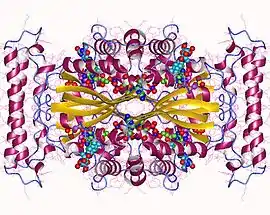Thymidylate synthase (FAD)
In enzymology, a thymidylate synthase (FAD) (EC 2.1.1.148) is an enzyme that catalyzes the chemical reaction
- 5,10-methylenetetrahydrofolate + dUMP + FADH2 dTMP + tetrahydrofolate + FAD
| thymidylate synthase (FAD) | |||||||||
|---|---|---|---|---|---|---|---|---|---|
 Flavin-dependent thymidylate synthase tetramer, Thermotoga maritima | |||||||||
| Identifiers | |||||||||
| EC no. | 2.1.1.148 | ||||||||
| Databases | |||||||||
| IntEnz | IntEnz view | ||||||||
| BRENDA | BRENDA entry | ||||||||
| ExPASy | NiceZyme view | ||||||||
| KEGG | KEGG entry | ||||||||
| MetaCyc | metabolic pathway | ||||||||
| PRIAM | profile | ||||||||
| PDB structures | RCSB PDB PDBe PDBsum | ||||||||
| Gene Ontology | AmiGO / QuickGO | ||||||||
| |||||||||
The 3 substrates of this enzyme are 5,10-methylenetetrahydrofolate, dUMP, and FADH2, whereas its 3 products are dTMP, tetrahydrofolate, and FAD.
This enzyme belongs to the family of transferases, to be specific those transferring one-carbon group methyltransferases. The systematic name of this enzyme class is 5,10-methylenetetrahydrofolate,FADH2:dUMP C-methyltransferase. Other names in common use include Thy1, and ThyX. This enzyme participates in pyrimidine metabolism and one carbon pool by folate.
Most organisms, including humans, use the thyA- or TYMS-encoded classic thymidylate synthase whereas some bacteria use the similar flavin-dependent thymidylate synthase (FDTS) instead.[1]
Structural studies
As of late 2007, 3 structures have been solved for this class of enzymes, with PDB accession codes 2AF6, 2CFA, and 2GQ2.
See also
References
- Koehn, E. M.; Perissinotti, L. L.; Moghram, S.; Prabhakar, A.; Lesley, S. A.; Mathews, I. I.; Kohen, A. (2012). "Folate binding site of flavin-dependent thymidylate synthase". Proceedings of the National Academy of Sciences. 109 (39): 15722–15727. Bibcode:2012PNAS..10915722K. doi:10.1073/pnas.1206077109. PMC 3465422. PMID 23019356.
- Myllykallio H, Lipowski G, Leduc D, Filee J, Forterre P, Liebl U (2002). "An alternative flavin-dependent mechanism for thymidylate synthesis". Science. 297 (5578): 105–7. Bibcode:2002Sci...297..105M. doi:10.1126/science.1072113. PMID 12029065. S2CID 12592540.